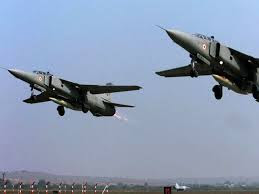IAF
says – “Ready for a 2-front war”. Really?
By: Kartikeya
Semwal
It is good to see that IAF (Indian Airforce) is
working hard to move from strength to strength by acquiring different types of
fighter planes, transport aircrafts and different types of helicopters. But this
doesn’t mean that it is ready to fight any type of war, especially when it is
about fighting a two-front war on western and eastern fronts. Though IAF has
been carrying out war games, operational exercises, joint exercises with
friendly countries but it doesn’t mean that it is ready and well equipped for a
two-front war.
The most important
point is still the same- lack of enough jet fighters to complete full
squadron-strength of 45. We all know that the last of Mig-21s were retired a
few months back in 2019 that had brought down IAF’s squadron strength to 33.
But recently, with retiring of Mig-27 3rd generation fighters
lovingly called “Bahadur” by IAF, the current squadron strength is down to a
dangerous low of 28. And if that was not enough then here me out loud- IAF
intends to retire upgraded jaguars and Mig-29s in the next 10 years.
Mig-27 "Bahadur"
So IAF’s statement of “we are ready to fight a two-front war” completely undermines itself. No doubt our Air Force chief and our brave pilots are patriotic and ready for challenges, but that doesn’t works when it comes to fighting a war. Numbers do matter, especially when you have a neighbour like China which is continuously upgrading its armed forces. China’s PLA-Airforce is working night & day to add over 600 aircraft including fighter jets in the next decade (10 years). Most of these are combat jets and are of 4th and 5th generation. Not to mention the J-10, J-15, J-20 and J-31.
Left to Right: J-10, J-15, J-20, J-31
Once they get those number of fighters up and
flying, they will gain control over not just all of Asia but also over the
Pacific region, which is of great importance for sea-trade, international
business and rich in resources. Now we all know that IAF is acquiring 40 Tejas
Mk-1 fighters followed by 43 Tejas Mk-1As totalling to 83 combat jets of 4th
generation. There have been talks about IAF might buy 114 Tejas Mk-II or MWF
but when & in how many years? Even if we consider that they will do so in
the next 10 years, but is that enough? Not at all.
Tejas Mk-1 & Mk-1A Concept Design
Rafale, considered as 4.5+ generation fighter that
has the calibre to take out 5th generation fighters of China (J-20
& J-31) are being acquired by IAF but only 36, and that too only by 2026.
Now the question arises- what it China attacks India in the next 1-3 years?
The answer is, if that happens IAF will be doomed.
Now it is clear that action is needed & at a fast pace. The one and only
solution to increase the number of IAF’s fighting squadrons to take on a
two-front war & ‘fight will full force’ is to ask HAL to increase the
production of LCA Tejas jets & buy at least 5-6 squadrons (80 to 98) of a
new jet fighter. But if they don’t want to buy it then they should at least take the
same number of fighter planes on lease for the next 10 years. IAF has already
zeroed in on Saab’s Gripen E & Boeing’s F/A-18 Super Hornet Block-III. Both
are at par with each-other and both are 4.5 generation fighters. Getting any
one of them will not only improve IAF’s firepower, but it will also make up the
numbers and nullify the psychological advantage China’s PLA Airforce has over
us.
Super Hornet Block-III
Meanwhile India can continue design-development
& production of Tejas Mk-II or the MWF (Medium Weight Fighter) that will be
a 4th+ generation twin-engine fighter and will form the backbone of
IAF in future. They are already carrying out induction of Tejas Mk-1s &
Mk-1As but that too needs to be speeded up to improve the numbers. If I were to
choose, I would go for Super Hornet Block-III. My reasons are simple:-
1. It
will bring a whole new set of technologies, hardwares, softwares, missiles and
ammunition. India will also get access to much-needed powerful engine & its
technology that HAL, DRDO & ADA have failed to make on their own over the
years.
2. Also,
Super Hornet is battle-proven & its war-fighting abilities are unknown to
both Pakistan & China.
3. Another
reason is that this fighter jet is not present in either Asia or in the Pacific
region. Thus, giving advantage to IAF and disadvantage to China coz they don’t
know much about it.
4. One
more reason is that it is cost-effective and IAF pilots have already flown
& tested it and are satisfied with its performance.
5. Last
but not the least. India can buy Boeing's 2 Super Hornets for the price of 1 Rafale jet being offered by France. So the numbers do matter.
If this happens, then IAF will actually ‘be ready
& fit’ to fight a two-front war if needed. Now I leave it up to all of you
reading this article as to what should be done to address the problem of IAF’s
depleting squadrons so they can match our eastern enemy. Feel free to comment below.







Comments
Post a Comment